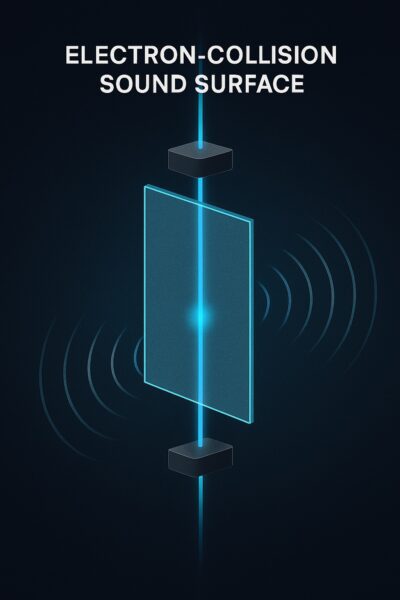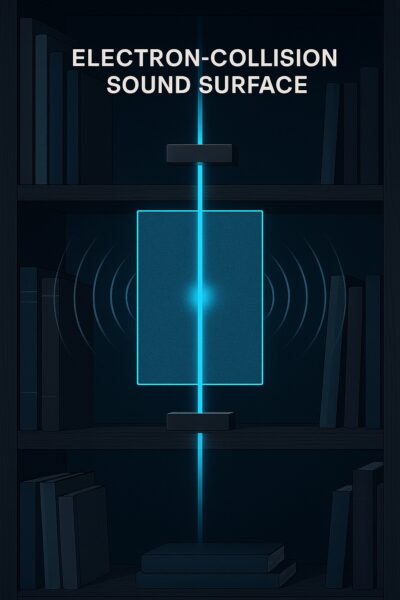By Manasse | October 2025
In a world increasingly shaped by digital interfaces and quantum precision, the way we generate sound may be on the verge of a radical transformation. Imagine a speaker with no moving parts, no vibrating cones, no membranes—just a transparent surface where sound is sculpted by the collision of electrons.
This is the concept behind Electron-Collision Sound Surfaces (ECSS), a speculative but scientifically plausible technology that could redefine how we experience audio.

🧪 The Physics Behind the Vision
At its core, ECSS relies on a transparent conductive material—perhaps graphene, indium tin oxide, or a future nanocrystal lattice—suspended between two electron emitters. These emitters, positioned above and below the surface, fire streams of electrons into the material. Where the streams intersect, electrons collide within the lattice, transferring kinetic energy to the atomic structure.
This energy causes localized vibrations, which propagate as sound waves into the surrounding air. By modulating the timing, intensity, and spatial coordinates of these collisions, one could recreate complex waveforms—essentially generating sound digitally, without mechanical movement.
⚙️ How It Would Work
- Electron Emitters: Controlled by software, these devices send precisely timed pulses of electrons into the material.
- Collision Modulation: The software defines where and when electrons collide, shaping the vibration pattern.
- Sound Emission: Vibrations in the material translate into audible sound, much like a traditional speaker—but with far greater spatial and temporal control.
This system could be embedded in glass, screens, or even wearable surfaces, offering transparent, ultra-thin, and digitally programmable sound generation.
🔍 Scientific Plausibility
While no such device exists today, the underlying principles are grounded in known physics:
- Electron-lattice interactions are well-studied in solid-state physics, especially in semiconductors and superconductors.
- Phonon generation (quantized sound waves) occurs when electrons transfer energy to a material’s atomic structure.
- Modulated electron beams are already used in scanning electron microscopes and lithography systems.
The challenge lies in scaling these interactions to produce audible sound efficiently and safely. But with advances in nanomaterials, MEMS (micro-electromechanical systems), and quantum control, the concept is within reach.
🌌 Applications and Implications
- Transparent Sound Walls: Architectural glass that doubles as a speaker system.
- Wearable Audio Interfaces: Clothing or visors that emit sound without visible hardware.
- Holographic Sound Fields: Spatially distributed audio zones for immersive environments.
- Neural Audio Stimulation: Direct modulation of sound patterns for therapeutic or cognitive applications.

🧠 A New Philosophy of Sound
ECSS isn’t just a new speaker—it’s a new way of thinking about sound. It treats audio as a quantum choreography, where electrons become brushstrokes and vibration becomes voice. It’s the convergence of physics, engineering, and poetic design.
In a future shaped by intentional technology and minimalist living, such systems could offer not just efficiency, but elegance. Sound, sculpted from silence—by electrons dancing in light.